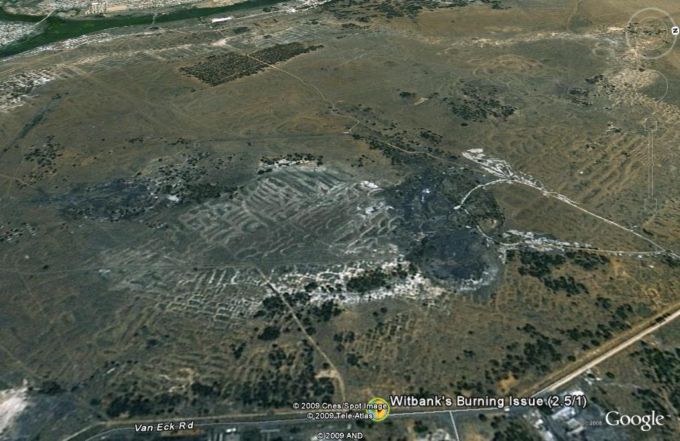Coal
Coal is South Africa’s primary energy source; it has been a major stimulus for economic growth and a significant factor in the country’s industrialization. South Africa is the fourth largest coal producer in the world, with an annual production of about 300 million t (EIA 2005).
Coal deposits are hosted by Permian age sediments of the Karoo Sequence, which forms a cover sequence for a large portion of South Africa. Witbank Coalfield is situated on the irregularly eroded northern margin of the Karoo Basin, about 130 km east of the city of Johannesburg. It is about 40 km in width and 180 km in length, stretching from the towns of Belfast in the east to Springs in the west. Witbank Coalfield is the focus of coalmining in South Africa and currently accounts for about 53 % of the country’s coal production.
One of the consequences of coal mining is the exposure of the coal to air and moisture resulting in the ignition of the coal through the processes of chemisorption, oxidation, and spontaneous combustion.
Collieries in the Witbank coalfield have historically used board and pillar mining with typically low coal recovery ratios, leaving a significant amount of coal in pillars, and as floor and roof coal. When old workings were reopened, ingress of air into galleries resulted in chemisorption and oxidation of coal leading to spontaneous combustion in some collieries.
How does spontaneous combustion occur?
The percolation of air through organic materials, including coal, results in a measurable rise in temperature. This phenomenon is also observed in crushed sulphide ore and is caused by a progressive series of adsorptive, absorptive, and chemical processes. The heat generated, if greater than that dissipated, gives rise to an increase in the temperature of the coal. As the temperature of the coal rises, the rate of coal oxidation increases. These reactions cause the self-heating of coal, and if conditions are favorable, spontaneous combustion can result. If the rate of heat generated by percolating air is equal to the rate of heat removed, equilibrium will be reached.
Spontaneous combustion is a phenomenon that occurs during coal mining (underground and opencast), storage (stockpiles, silos), waste disposal (waste dumps, backfilling) and transportation. This is also not isolated to only Witbank but many coalmining countries have the same, or much worse, problem.
The case study:
The old, abandoned Transvaal and Delagoa Bay colliery (T&DB), in Witbank appears relatively normal at first sight. On closer inspection, sink holes associated with in situ combustion of coal are evident. Bare patches are present around the sinkholes and gases are vented into the atmosphere.
 The colliery began operating in 1896. Fires soon began, but were controlled while the mine was still operational. After the closure of the mine in 1953, many areas of the mine collapsed and subsided. This resulted in a combination of problems, including acid mine drainage and spontaneous combustion giving rise to further subsidence and air pollution.
The colliery began operating in 1896. Fires soon began, but were controlled while the mine was still operational. After the closure of the mine in 1953, many areas of the mine collapsed and subsided. This resulted in a combination of problems, including acid mine drainage and spontaneous combustion giving rise to further subsidence and air pollution.
Although many of the old mine shafts were capped and sealed, the majority of these seals have failed or have been removed, accelerating spontaneous combustion of the coal. These fires have been out of control and in 1995 flames could be seen above ground.
The 750 ha colliery site lies between the township of KwaGuqa and the industrial area of Ferrobank. Footpaths crisscross it, passing close to burning areas. Underground fires are not the only problem at the site. Acid water decants into the nearby Brugspruit which flows by the nearby settlements of KwaGuqa, Vosman and further on Middelburg and into the stream that feeds the Loskop dam.
The operation closed before rigorous closure practice was common and the former owners are no longer traceable. Rehabilitation of the site, now the responsibility of the state, may cost up to R100-million. Investigations regarding the methods of rehabilitating the T&DB Colliery were finalized. These methods included re-mining, blast and collapse, flooding and ashing.
Another piece of interesting history.
This was the mining company where Winston Churchill was hidden after his escape during the Anglo Boer War.
To log the find you need to do the following and sent it to me:
1. Look at the Google Earth image above and the surface of the site. Give a description of the patterns you see and explain why you think it looks like that.
2. Do you see any smoke coming from the earth or any sinkholes? Please place some photos thereof in your log if you do.
3. Name one other place where spontaneous combustion occurred during coal mining operations.
NOTES:
- You do not need to go on the terrain to log your find;
- You can email me your answers in either Afrikaans or English.
Uploading photos to the cache page is the best way to say thank you to the cache developer and to encourage others to visit the location but is only optional.
Some other interesting reading regarding the spontaneous combustion in the Witbank Coalfields:
Mine closure as a framework for sustainable development ;
Potential Environmental and Health Impacts of Burning Coal in Witbank Coalfield, South Africa;
The spontaneous combustion of coal and its by-products in the Witbank and Sasolburg coalfields of South Africa, CAT.INIST;
The spontaneous combustion of coal and its by-products in the Witbank and Sasolburg coalfields of South Africa, International Journal of Coal Geology;
and another EarthCache, Centralia, The Burning Town EarthCache
To learn how coal was formed, you can visit Redglobe’s Kwazulu-Natal Coalfields EarthCache at Link